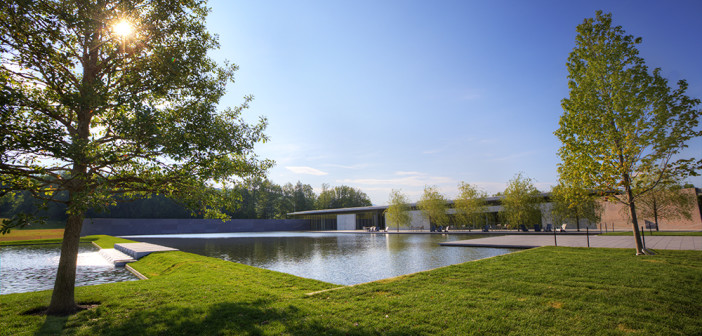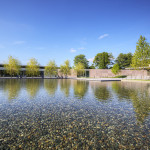On July 4th, The Clark reopened its doors, nearly completing its ambitious multi-phased expansion plan fifteen years the making. Initiated in 2001 and advanced with the 2008 opening of the Lunder Center at Stone Hill, the expansion plan has added over 97,000 square feet of space to the campus, underscored the institution's commitment to best practices for sustainability and energy efficiency, and developed its dual mission--to function both as an art museum as well as a center for research, critical discussion and higher education. This phase of the expansion includes the new Tadao Ando designed Clark Center, an expansion and renovation by Selldorf Architects of the original Museum Building, and an ambitious redesign of the grounds by Reed Hilderbrand Landscape Architecture.
Photo: Tucker Bair
Perspective is everything and the museum’s entrance has been dramatically reconfigured: Tadao Ando's Clark Center sits at the back of the original marble building and is approached via a long walk flanked on one side by a long granite wall. The wall is a strong architectural element: it reconfigures the campus’s orientation on a west to east axis; obscures the original marble building from view and instead, presents visitors with a stunning and beautifully landscaped series of tiered reflecting pools, a majestic view of Stone Hill Pasture and the museum’s 140 acre campus beyond. It’s a beautiful, fresh entrance that both slows and opens the visitor experience in different and potent directions.
The Clark maintains an open campus and the new entrance mirrors that perfectly: the large glass doors give easy and immediate access to the terrace and reflecting pools as well as the institution’s newly marked trail system. Both features are rewarding destinations in and of themselves. The trail system is supported by a lushly notated brochure/trail guide which promises "a special experience with nature--from tiny fungi to distant mountain vistas." With over four miles of diverse trails through scenic meadows, pastures and woods, the trail system connects visitors to the Lunder Center at Stone Hill, and the museum’s natural pastoral setting. The walk to Stone Hill Pasture is especially picturesque and full of mise-en-scène inspiring vistas.
The Clark Center also houses new multi-level exhibition spaces, a café, and admissions kiosk. Entrance into the Sterling and Francine Clark collection itself, is accessed off to the left--past a gift shop, through a long glass and granite passage that offers views of the terrace, reflecting pools, ponds, and donor wall. It lands visitors at the rear of the original Museum Building, an all-white neo-classical marble temple designed by Daniel Perry and opened in 1955. The marble building is completely enclosed by this long arm of the new Clark Center, in an open glass foyer that presents the original building as a museum piece in and of itself.
The interior of the original Museum Building has a domestic feel and intimate scale (the Clarks in fact lived in the building during their stays in the Berkshires). Selldorf Architects of New York, charged with enhancing the building’s gallery spaces, have added more than 2,200 square feet of gallery space while still maintaining this domestic character. The permanent collection--mostly eighteenth and nineteenth-century French art--is studded with works by Renoir, Monet, Degas, and Pissaro. American painters John Singer Sargent, Innes, Remington and Winslow Homer also form a significant part of the collection; and the 2007 gift of the Manton Collection added works by British painters J.M.W. Turner, John Constable, and Thomas Gainsborough. The Clarks also collected English silver and European porcelain which are handsomely displayed in outer rooms.
Approaching the original collection through the building’s rear entrance is a subtle, but effective bit of architectural theater that invites some fresh perspectives on the permanent collection housed within: What was leisure? What was art patronage? How did art relate to nature and vice versa? These are still relevant questions and the new design at the Clark, by framing the permanent collection in this way, gives it new currency as it opens these lines of dialog. Four Jenny Holzer stone benches that sit just outside foyer help reiterate these potential lines of thinking.
The inaugural exhibitions in the Clark Center and at the Lunder Center at Stone Hill couldn’t be more perfect. "Cast for Eternity: Ancient Ritual Bronzes from the Shanghai Museum" features thirty-two ceremonial bronze vessels and a set of bells from the Shanghai Museum’s renowned collection--objects seldom seen outside of China. Accompanied by a fully illustrated catalogue, the exhibition is the latest in an ongoing relationship between the Clark and China’s Ministry of Culture. "Make It New: Abstract Painting from the National Gallery of Art, 1950—1975" also in the Tadao Ando Clark Center, showcases Pollock’s iconic Lavender Mist as well as works by Jasper Johns, Richard Tuttle, Helen Frankenthaler, Morris Louis and more. Focusing on this fertile twenty-five year time frame, the exhibition offers a deep examination of various threads in American abstract painting. The third exhibition, "Raw Color: The Circles of David Smith" at the Lunder Center at Stone Hill, is most impressive. His Primo Piano II of painted stainless steel, and bronze painted a luminous white is installed on an outer terrace at the near apex of the Clark campus and is seen against the sky. Seen together, and primed through the lens of the new campus with its reflecting pools and beautifully landscaped grounds, the exhibitions resonate with broad ideas about originality, nature, leisure, and place.
The final phase of the Clark’s expansion will include the completed renovation of the Manton Research Center. The center currently houses temporary exhibition space, an auditorium, an excellent bookstore as well as the museum’s impressive library resources--approximately 235,000 books, bound periodicals, auction sales catalogues and journal subscriptions. Free and open to the public, it’s one of the country’s largest libraries of its kind. A critical element of the Manton renovation is the addition of a skylight system that will transform the former visitor center into a large, light filled and open public reading room. By bringing research and academic study closer to the visitor experience, the Clark may reposition itself, not just as museum with a collection of objects for viewing but as a place for meditating on art’s meaning and import. It may transform itself from museum to contemplative think-tank.
- Detail of Clark Center and reflecting pool. Photo: Tucker Bair
- Clark Center and reflecting pool. Photo: Tucker Bair
- Clark Center and reflecting pool. Photo: Tucker Bair
- Museum Building installation. Photo: Mike Agee
- Museum Building installation. Photo: Mike Agee
The Clark is located in Williamstown, Massachusetts.
For more information, visit the museum's website www.clarkart.edu









